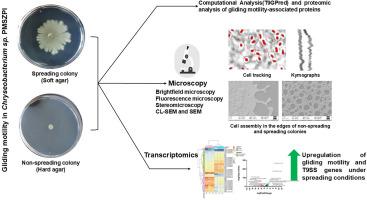从铀矿石矿床中分离的 PMSZPI Chryseobacterium 菌株在硬基质和软基质上的不同滑行运动反应
IF 5.8
Q1 MICROBIOLOGY
引用次数: 0
摘要
从铀矿床地下土壤中分离出的类杆菌科细菌 Chryseobacterium sp.菌株 PMSZPI 通过滑行运动在固体表面移动,并形成薄薄的扩散菌落。在本研究中,我们试图了解软硬/刚性表面对 PMSZPI 细胞运动行为的影响。计算工具 T9GPred 与 LC-MS/MS 分析相结合,确定了 PMSZPI 中存在重要滑行运动蛋白的直向同源物。我们分析了 PMSZPI 在平展和非平展条件下的单细胞或群体运动表型。营养水平较低的低比例琼脂或软琼脂(0.35 %)会诱导单个细胞更活跃地滑行运动,从而导致菌落扩散增加。显微镜分析表明,根据琼脂浓度的不同,滑行细胞自组装成边缘不规则或球形的微菌落。细胞在低浓度滑动许可琼脂(0.35%)表面的移动速度为 0.6 µm s-1,而在硬质或硬琼脂(1.5%)表面的移动速度则明显受到抑制。RNA 测序和实时定量 PCR(qPCR)分析表明,在低琼脂条件下,滑翔运动基因的表达量增加,这与扩散行为的增加相一致。这些发现首次揭示了富集金属环境中类杆菌的滑翔运动行为,显然可能对细菌适应不断变化的表面环境产生影响。本文章由计算机程序翻译,如有差异,请以英文原文为准。

Differential gliding motility responses of Chryseobacterium sp. strain PMSZPI isolated from uranium ore deposit on hard and soft substrates
The Bacteroidota bacterium, Chryseobacterium sp. strain PMSZPI isolated from sub-surface soil of uranium ore deposit was shown to move on solid surfaces via gliding motility resulting in the formation of thin spreading colonies. In this study, we attempted to understand the influence of the surfaces, soft or hard/rigid, on the motility behaviour of PMSZPI cells. The computational tool T9GPred in combination with LC-MS/MS analysis established the presence of orthologs of vital gliding motility proteins in PMSZPI. We analyzed the single cell or population motility phenotypes of PMSZPI under spreading and non-spreading conditions. A low percentage of agar or soft agar (0.35 %) with low nutrient levels induced more active gliding motility in individual cells leading to increased colony spreading. Microscopic analyses indicated the self-assembly of the gliding cells into irregular edged or spherical microcolonies based on the agar concentration. Cells moved at a speed of 0.6 µm s-1 on low-percentage gliding permissive agar (0.35 %) surface in contrast to significant inhibition of motility on rigid or hard agar (1.5 %) surface. RNA sequencing and real-time quantitative PCR (qPCR) analysis revealed increased expression of gliding motility genes under low agar conditions consistent with increased spreading behaviour. These findings provide the first glimpse into the gliding motility behaviour of a Bacteroidota bacterium from metal enriched environment that apparently could have implications on bacterial adaptation to changing surface environments.
求助全文
通过发布文献求助,成功后即可免费获取论文全文。
去求助
来源期刊

Current Research in Microbial Sciences
Immunology and Microbiology-Immunology and Microbiology (miscellaneous)
CiteScore
7.90
自引率
0.00%
发文量
81
审稿时长
66 days
 求助内容:
求助内容: 应助结果提醒方式:
应助结果提醒方式:


